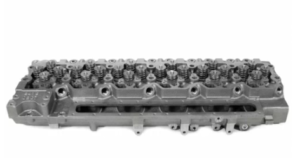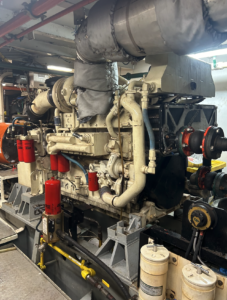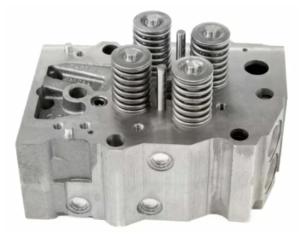March 27, 2025
Introduction to the Cummins QSC Cylinder Head
Why the Cylinder Head Matters in the QSC 8.3 Engine
Key Responsibilities of the Cylinder Head
Common Signs Your Cylinder Head Needs Replacement
1. Loss of Compression
2. Coolant and Oil Mixing
3. Overheating
4. Blue or White Exhaust Smoke
5. External Cracks or Leaks
Why Diesel Pro Power Cylinder Heads Are the Smart Choice
Factory-Fresh, Not Rebuilt
Assembled and Ready to Install
Machined for Modern Fuel Systems
Designed for Harsh Marine Environments
In Stock and Ready to Ship
Specifications and Compatibility
Technical Specifications
Compatible CPL Numbers
Installation Guidelines and Best Practices
Surface Preparation
Head Gasket and Bolt Replacement
Torque Pattern and Sequence
Valve Lash Adjustment
Advantages of a New Head vs. Remanufactured or Used
Use Cases: Where QSC Cylinder Heads Are Most Needed
Commercial Fishing Vessels
Marine Ferries and Workboats
Industrial and Stationary Power
Maintenance Tips to Extend Cylinder Head Life
Use Proper Coolant Mixture
Avoid Overloading the Engine
Monitor Oil Quality and Level
Schedule Regular Valve Adjustments
How to Order From Diesel Pro Power
Step 1: Confirm Your Serial Number
Step 2: Contact Technical Support
Step 3: Place Your Order
Step 4: Receive Your Part
Diesel Pro Power: Why Professionals Trust Us
Final Thoughts
Read More

March 26, 2025
Crankshaft and Related Components For Cummins KTA50
Introduction to the Crankshaft System For Cummins KTA50
Function of the Crankshaft in the KTA50
Materials and Construction of the Crankshaft For Cummins KTA50
Crankshaft Design Characteristics For Cummins KTA50
Associated Components With the Crankshaft For Cummins KTA50
1. Main Bearings
2. Connecting Rods and Bearings
3. Crankshaft Seals
4. Flywheel and Ring Gear
5. Vibration Damper
Common Crankshaft Issues and Failure Modes For Cummins KTA50
1. Bearing Wear or Seizure
2. Crankshaft Scoring
3. Crankshaft Cracks
4. Thrust Bearing Failure
1. Runout Measurement
2. Journal Diameter Check
3. Fillet Radius and Oil Hole Inspection
Regrinding and Polishing Procedures For Cummins KTA50 Crankshafts
Crankshaft Installation Guidelines For Cummins KTA50
Torque Specs and End Play Limits For Cummins KTA50 Crankshaft
Crankshaft Lubrication System Overview For Cummins KTA50
Key Points:
Preventive Maintenance Tips For Cummins KTA50 Crankshaft
When to Replace or Rebuild a Crankshaft For Cummins KTA50
Recommended Parts From Diesel Pro Power
FAQ – Crankshaft and Components For Cummins KTA50
Additional Resources For The Cummins KTA50
Additional Resources
Read More

March 26, 2025
Cummins QSK19 Marine Engine
Introduction
Key Features of the Cummins QSK19
Where You’ll Find the QSK19 at Work
What Sets the QSK19 Apart?
Most Common QSK19 Parts You’ll Need
QSK19: Specs at a Glance
Final Thoughts
Read More
March 26, 2025
Applications and Support
Why Choose Diesel Pro Power?
Disclaimer
Final Notes
Engine Specifications for Cummins KTA 19
Applications of the Cummins KTA 19 Engine
Marine Applications
Industrial Applications
Read More
March 26, 2025
Cylinder Block For Cummins KTA19
Introduction To The Cylinder Block For Cummins KTA19
Construction and Design Features For Cummins KTA19
Key Design Elements:
Purpose of the Cylinder Block:
Cylinder Liners and Deck Surface For Cummins KTA19
Oil and Coolant Passages For Cummins KTA19
Cylinder Block Removal Procedure For Cummins KTA19
Cylinder Block Inspection For Cummins KTA19
Cylinder Block Machining and Reconditioning For Cummins KTA19
Cylinder Block Installation For Cummins KTA19
Preparation Checklist:
Installation Steps:
Troubleshooting Common Cylinder Block Issues For Cummins KTA19
1. Coolant in Oil
2. Low Oil Pressure
3. Head Gasket Failure
4. Crankshaft Misalignment
5. Excessive Blow-by
Tips for Extending Cylinder Block Life For Cummins KTA19
Replacement and Aftermarket Options For Cummins KTA19 Cylinder Block
FAQ Section – Cylinder Block For Cummins KTA19
Read More
March 24, 2025
Applications and Support
Why Choose Diesel Pro Power?
Disclaimer
Final Notes
Engine Specifications for Cummins KTA 19
Applications of the Cummins KTA 19 Engine
Marine Applications
Industrial Applications
Read More
Page 3 of 56«12345...102030...»Last »




 Free US Calls: 1-888-433-4735
Free US Calls: 1-888-433-4735 International: 305-545-5588
International: 305-545-5588


